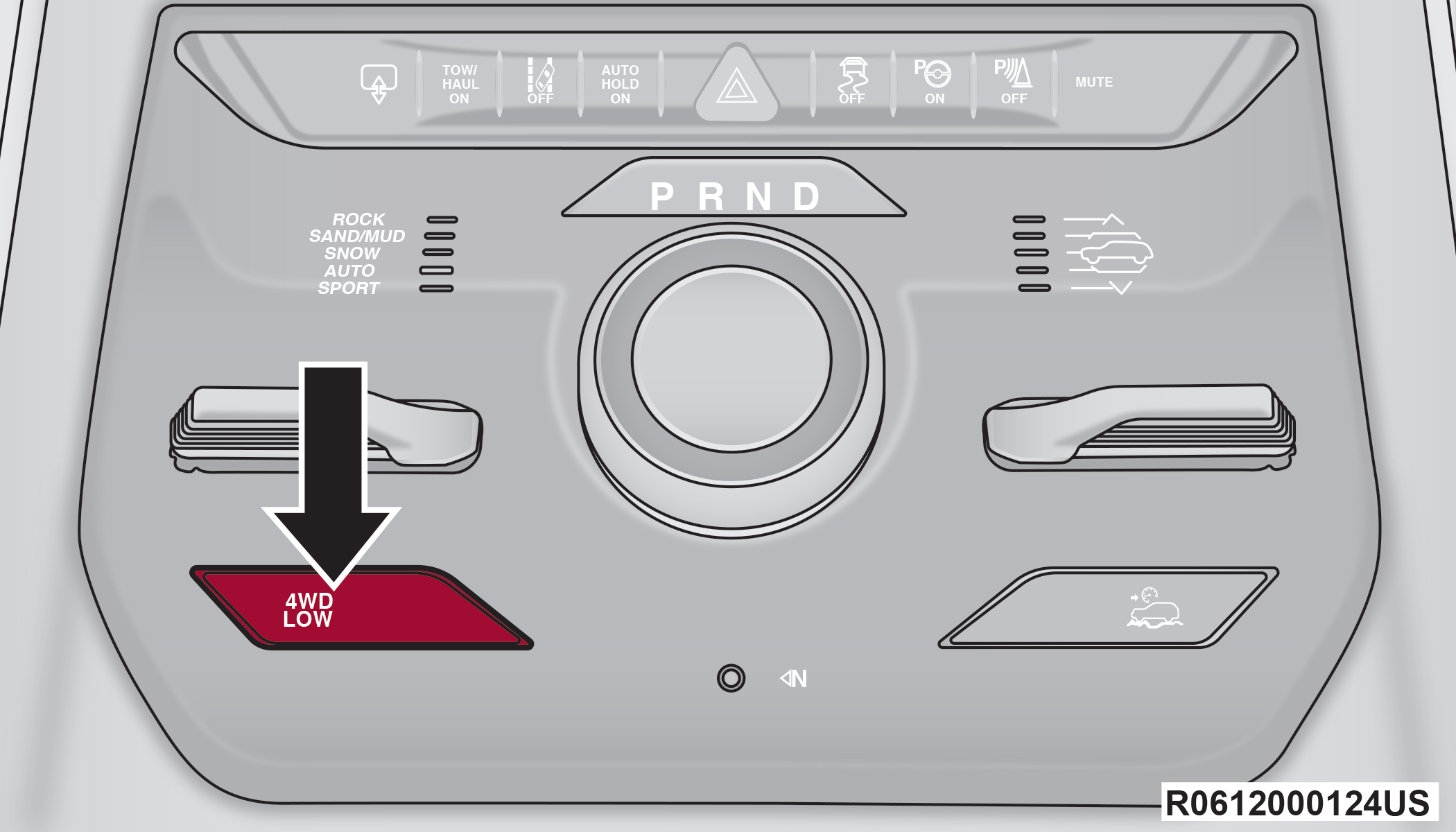Quadra-Trac I Operating Instructions/Precautions — If Equipped
The Quadra-Trac I is a single-speed (HI range only) transfer case, which provides convenient full-time four-wheel drive. No driver interaction is required. The Brake Traction Control (BTC) System, which combines standard ABS and Traction Control, provides resistance to any wheel that is slipping to allow additional torque transfer to wheels with traction.
The Quadra-Trac I system is not appropriate for conditions where 4WD LOW range is recommended Off-Road Driving Tips.
Quadra-Trac II Operating Instructions/Precautions — If Equipped
The Quadra-Trac II transfer case is fully automatic in the normal driving 4WD AUTO mode. The Quadra-Trac II transfer case provides three positions:
4WD AUTO
N (Neutral)
4WD LOW
When additional traction is required, the 4WD LOW position can be used for increased torque at the wheels. Driving in the 4WD LOW position on dry, hard-surfaced roads may cause increased tire wear and damage to driveline components.
When operating your vehicle in 4WD LOW, the engine speed is approximately three times that of the 4WD AUTO position at a given road speed. Take care not to overspeed the engine and do not exceed 25 mph (40 km/h).
Proper operation of four-wheel drive vehicles depends on tires of equal size, type, and circumference on each wheel. Any difference will adversely affect shifting and cause damage to the transfer case.
Because four-wheel drive provides improved traction, there is a tendency to exceed safe turning and stopping speeds. Do not go faster than road conditions permit.
You or others could be injured or killed if you leave the vehicle unattended with the transfer case in the N (Neutral) position without first fully engaging the parking brake. The transfer case N (Neutral) position disengages both the front and rear drive shafts from the powertrain and will allow the vehicle to roll, even if the transmission is in PARK. The parking brake should always be applied when the driver is not in the vehicle.
Shift Positions
For additional information on the appropriate use of each four-wheel drive system mode position, see the following information:
4WD AUTO
This range is the default operating mode for daily use.
N (NEUTRAL)
This range disengages the driveline from the powertrain. It is used for towing your vehicle behind another vehicle RECREATIONAL TOWING (BEHIND MOTORHOME).
You or others could be injured or killed if you leave the vehicle unattended with the transfer case in the N (Neutral) position without first fully engaging the parking brake. The transfer case N (Neutral) position disengages both the front and rear drive shafts from the powertrain and will allow the vehicle to roll, even if the transmission is in PARK. The parking brake should always be applied when the driver is not in the vehicle.
4WD LOW
This range is for low speed four-wheel drive. It provides an additional gear reduction which allows for increased torque to be delivered to both the front and rear wheels while providing maximum pulling power for loose, slippery road surfaces. Do not exceed 25 mph (40 km/h).
Shifting Procedures
4WD AUTO To 4WD LOW
With the vehicle at speeds of 0 to 3 mph (0 to 5 km/h), the ignition switch in the ON position or the engine running, shift the transmission into NEUTRAL (N), and push and hold the 4WD LOW button once on the transfer case switch until the 4WD LOW indicator light begins to flash in the instrument cluster. The 4WD LOW light will remain on solid when the shift is complete.

4WD LOW Button
If shift conditions/interlocks are not met a message will show on the instrument cluster display with instructions required to complete the shift INSTRUMENT CLUSTER DISPLAY.
4WD LOW To 4WD AUTO
With the vehicle at speeds of 0 to 3 mph (0 to 5 km/h), the ignition switch in the ON position or the engine running, shift the transmission into NEUTRAL (N), and push the 4WD LOW button once on the transfer case switch until the 4WD LOW indicator light begins to flash in the instrument cluster. The 4WD LOW light will go out when the shift is complete.
If shift conditions/interlocks are not met a message will show on the instrument cluster display with instructions required to complete the shift INSTRUMENT CLUSTER DISPLAY.
Shifting into or out of 4WD LOW is possible with the vehicle completely stopped; however, difficulty may occur due to the mating clutch teeth not being properly aligned. Several attempts may be required for clutch teeth alignment and shift completion to occur. The preferred method is with the vehicle rolling 0 to 3 mph (0 to 5 km/h). If the vehicle is moving faster than 3 mph (5 km/h), the transfer case will not allow the shift.
Quadra-Drive II System — If Equipped
The Quadra-Drive II System features two torque transfer couplings. The couplings include an Electronic Limited-Slip Differential (ELSD) rear axle and the Quadra-Trac II transfer case. The ELSD axle is fully automatic and requires no driver input to operate. Under normal driving conditions, the unit functions as a standard axle, balancing torque evenly between left and right wheels. With a traction difference between left and right wheels, the coupling will sense a speed difference. As one wheel begins to spin faster than the other, torque will automatically transfer from the wheel that has less traction, to the wheel that has traction. While the transfer case and axle coupling differ in design, their operation is similar. Follow the Quadra-Trac II transfer case shifting information, preceding this section, for shifting this system.